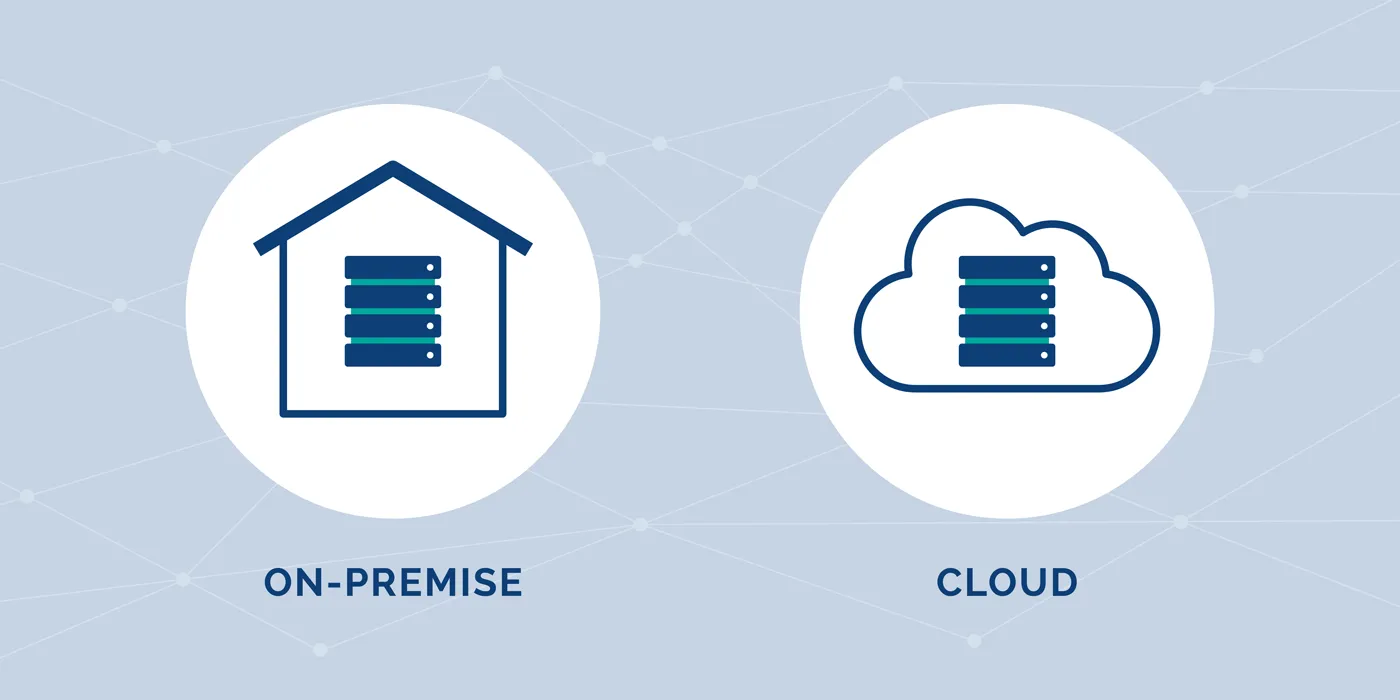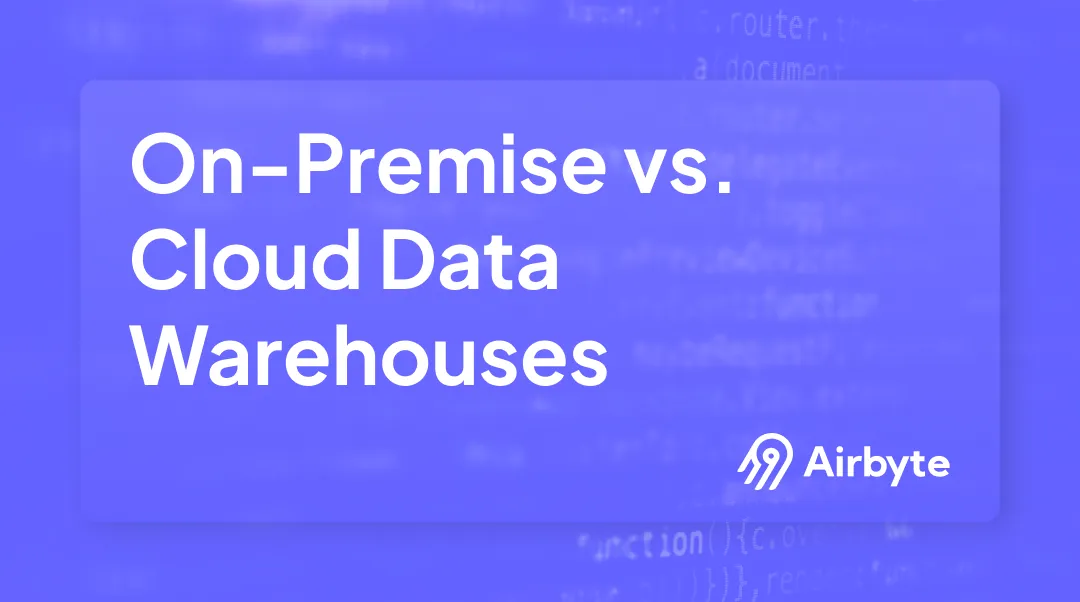On-Premise vs. Cloud Data Warehouses: The Comparison Guide
Summarize this article with:
✨ AI Generated Summary
A data warehouse centralizes data for analytics and decision-making, available as on-premise or cloud-based solutions. Key differences include:
- On-premise offers full control, physical infrastructure, and strong security but requires high upfront costs and limited scalability.
- Cloud warehouses provide scalability, reduced maintenance, and flexible pay-as-you-go pricing but depend on network connectivity and expose data to providers.
- Hybrid approaches combine both models for optimized performance and security.
- Tools like Airbyte facilitate seamless data integration across on-premise and cloud warehouses with extensive connectors and automation features.
A data warehouse plays a critical role in data management by centralizing data from disparate sources to one single source of truth. You can use this centralized data to perform analytics and make informed decisions to optimize business operations. Data warehouses are typically categorized into two types: on-premise and cloud. On-premise data warehouses are a much more traditional way of dealing with data, and cloud-based ones are modern ones.
However, as a data professional, you might face a challenge while deciding what type of data warehouse to use. Therefore, in this article, we will discuss on-premise vs. cloud data warehouses and compare both types in detail to help you make your decision. So, let’s get started!
What is an On-Premise Data Warehouse?
As mentioned above, an on-premise data warehouse is a traditional way of managing and centralizing data in a storage system. It is a fully customized data warehouse that you can use to collect, store, and analyze your data.
You are responsible for building the infrastructure of the on-premise data warehouse. It allows you to purchase, deploy, and maintain hardware and software according to your business requirements.
An on-premise data warehouse resides on a local system bordered within an organization and has a physical presence. The idea with these data warehouses is that you have complete control over the data stored in the system. This includes security, analytics, business intelligence, and the data governance aspect of the data warehouse.
However, a common challenge with on-premise data warehouses is that they require a lot of investment to buy all the required hardware, software, and a dedicated team to manage data efficiently.
Some well-known on-premise data warehouses include Teradata, IBM Db2, and Oracle autonomous data warehouse.
What is a Cloud Data Warehouse?
A cloud data warehouse is a database that operates as a managed data storage and analysis service in a cloud environment. It is an enterprise system that you can use to analyze and report structured and semi-structured data from disparate sources. Just like on-premise, cloud-based data warehouses are also used to collect, store, and manage data in a structured way.
Cloud vendors build and manage the infrastructure of a cloud data warehouse, enabling you to focus on running more crucial business operations rather than managing a server room. It is a modern way of handling huge datasets in a public or private cloud to help perform analytics and business intelligence tasks.
A cloud environment in a data warehouse offers many benefits over on-premise systems, such as overcoming physical data center constraints and increasing accessibility.
Popular cloud data warehouses today include Snowflake, Redshift, BigQuery, and Cloudera.
On-Premise Vs Cloud Data Warehouse: In-Depth Comparison
The main difference between an On-Premise Data Warehouse and a Cloud Data Warehouse is that an On-Premise Data Warehouse is hosted locally, offering full control but requiring significant infrastructure, while a Cloud Data Warehouse is hosted on the cloud, providing scalability, flexibility, and reduced maintenance.

On-Premise vs Cloud Data Warehouse: Architecture
The on-premise data warehouse uses a three-tier architecture: bottom, middle, and top tiers. The bottom tier is a storage layer, the middle tier is a compute layer, and the top tier is a services layer. Here's what each layer includes:
- Storage Layer: It is the foundation of a data warehouse, including a database server, storage media, a meta-repository, and data marts.
- Middle Tier: This is an online analytical processing server. It processes complex queries to present results in a form suitable for data analytics, mining, and business intelligence.
- Top Tier: A user interface or front end of the data warehouse holds tools for high-level data analysis, querying, or reporting.
On the other hand, the cloud data warehouse does not adhere to the traditional architecture. The catch with these data warehouses is that each system has a unique architecture according to its features and functionalities. However, some of the elements that are the same in most cloud data warehouses include:
- Nodes: These are the computing resources, along with their CPUs, RAM, and memory.
- Clusters: Large group of nodes.
- Partitions: a slice of node.
A cluster made of two or more nodes is a leader node, which is responsible for communicating with client apps to execute queries.
Often, cloud data warehouses also have independent storage and compute capabilities, thereby ensuring more flexibility in their overall architecture.
On-Premise vs Cloud Data Warehouse: Scalability
On-premise data warehouses lack scalability. You need to purchase additional storage hardware whenever you want to expand computing or storage resources. This also requires a lot of time and effort to set it up and start working with more data. In addition, if you need to scale down for some reason, you might end up with unwanted hard drives.
Conversely, cloud data warehouses allow you to scale up and down according to your requirements by changing subscription tiers. You don't have to perform any infrastructural work. Your cloud provider can allocate as much space and scalability as you want. Therefore, if scalability is your concern, then cloud-based solutions are an ideal choice.
On-Premise vs Cloud Data Warehouse: Performance
On-premise data warehouses allow you to tailor hardware specifications to meet specific performance requirements such as memory capacity, CPU processing, and so on. They usually rely on the physical location of data and processing resources, which can limit their performance. On-premise systems may have limitations in performance and scalability, but these data warehouses have low network latency because data processing happens in the internal network.
On the other hand, cloud data warehouses leverage distributed computing architectures that enable parallel processing of data across distributed clusters. This distributed architecture ensures consistent performance as user concurrency increases. However, cloud data warehouses rely on network connectivity between the organization's premises and the cloud providers' data centers, which can sometimes cause network latency.
On-Premise vs Cloud Data Warehouse: Security
If you have sensitive data that you want to keep within your organization's network, an on-premise solution is ideal. Using an on-premise data warehouse, you can implement firewalls, online VPN, role-based access control (RBAC), and encryption algorithms of your choice. Since you have direct control over every aspect of security implementation, it is more secure when a rigid data policy is supported. Industries like finance, healthcare, and telecommunication, which deal with sensitive data, usually use on-premise data warehouses.
In cloud data warehouses, cloud service providers manage the physical security of network security, data centers, and hardware maintenance. It offers flexible security features, including identity and access management tools, multi-factor authentication, and encryption. Therefore, cloud data warehouses also have robust security measures, but they expose your data to cloud service providers.
On-Premise vs Cloud Data Warehouse: Cost
On-premise data warehouses are very cost—and resource-intensive. For a data-driven organization, you must purchase physical hardware, maintain data center infrastructures, and dedicate IT staff to data warehouse management. All this requires a lot of time, expertise, and cost.
On the contrary, cloud-based data warehouses require no physical server to acquire or set up. Instead, cloud providers take care of hardware, management, and updates. You only have to pay for the storage and processing time you require. These solutions follow a pay-as-you-go model that gives you flexibility in paying for what you use.
Integrate Data to On-premise and Cloud Based Data Warehouses Using Airbyte

After learning about on-premise and cloud-based data warehouses, you might want to implement a hybrid approach using both models. Tools like Airbyte can streamline this task for you.
Airbyte is a data integration tool that connects disparate sources to your on-premise or cloud data warehouse. With over 350+ pre-built connectors, the platform has the largest library of connectors that can automate data ingestion. You might say connectors take the flexibility away from data management, but that's not the case with Airbyte.
With the new PyAirbyte feature of Airbyte, you can install a library with a package of all Airbyte connectors and make them available as code. This will allow you to move data and transform using Python programming according to your use cases.
Beyond connectors, Airbyte also provides an intuitive user interface, orchestration capabilities, and flexible pipeline creation capabilities.
Overall, if you have any data integration requirements, Airbyte has them covered.
Conclusion
On-premise and cloud data warehouses have their use cases, and you can choose which suits your requirements best. However, you don't have to choose between the two. Many organizations combine both data warehouses to create a robust data management infrastructure called the hybrid approach. In this approach, you can use a cloud repository to take server, scalability, and performance advantages with a specialist on-premise data warehouse for sensitive data storage and low network latency.
For on-premise vs cloud vs hybrid data warehouse, whatever you choose, you can use Airbyte to streamline your data integration tasks. More than 40,000+ engineers use Airbyte to replicate data. Sign up with Airbyte today!

